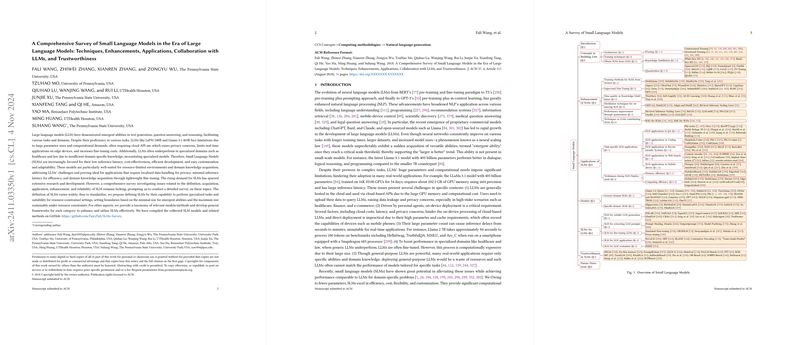Overview of Small LLMs: Techniques and Applications
The paper, authored by Fali Wang et al., explores the comprehensive landscape of Small LLMs (SLMs) during a dominantly emergent era of LLMs. The inherent advantages of SLMs such as reduced inference latency and enhanced cost-effectiveness make them preferable over LLMs for tasks necessitating efficiency, privacy, and customization. This essay evaluates the focal points from the survey, examining myriad techniques, enhancements, applications, and inherent trust issues related to SLMs, while also anticipating future directions.
Defining and Leveraging SLMs Against LLMs
SLMs were crucially defined by their capabilities to perform specialized tasks sustainably under constrained resources. The paper thoroughly elucidates the limitations of LLMs—such as exorbitant parameter sizes, scaling challenges, and computational overheads—in contexts like healthcare, law, and other specialized domains where domain-specific adaptiveness is paramount. Emphasizing SLMs' adaptability, the authors meticulously analyze strategies including quantization, pruning, and knowledge distillation, which proficiently make SLMs versatile, requiring minimal resources while supporting efficient local data processing.
Enhancements and Optimization Techniques
Noteworthy is the adoption of structured and unstructured pruning methodologies alongside various tailored knowledge distillation approaches, each chosen to align the model’s performance with specific domain demands. SLMs benefit from advancements like quantization-aware training to bolster performance in energy-constrained environments, facilitating crucial developments on edge devices such as mobile phones. Additionally, notable training techniques highlighting parameter-efficient methodologies like Low-Rank Adaptation (LoRA) ensure these models are incrementally advanced and adaptable for domain-centric enhancements.
Domains and SLM Applications
SLMs, due to low inference latency and customization capabilities, are becoming indispensable across numerous tasks. Their deployments, notably in mobile applications and sensitive domains like healthcare, telecommunication, and scientific computation, exemplify their practicality. domainspecific SLMs like BioMedLM in healthcare, and MentaLLaMA for mental health analysis illustrate significant contributions wherein precise domain knowledge is paramount. Given these factors, the authors suggest significant future expansion of SLMs across presently underexplored domains such as law and finance.
Trustworthiness and Real-world Deployments
The paper insightfully discusses trustworthiness, focusing on areas such as robustness, reliability, fairness, and privacy. Addressing these factors becomes critically important, mainly when deploying SLMs in high-stake fields. Theoretical and empirical evaluations concerning adversarial robustness, reliability against hallucinations, and ways to assure data privacy and fairness establish a strong baseline for further developments. The robustness of SLMs against non-adversarial scenarios and misinformation remarkably sheds light on improvement pathways regarding trust.
Future Directions and Speculated Developments
An assertive nano-contribution of this survey lies within its offering of insightful future directions. The authors constructively engage readers with speculative elements suggesting SLM advancements in benchmarking platforms, efficient model architectures, and collaborative relationships with LLMs to further elevate their effectiveness. Technological exploration in SLMs seems pivotal, particularly focusing on integrated mechanisms like RAG and self-adaptive methods for optimization in real-world applications, elevating resource-bound settings such as on-device personalization and continuous learning.
In conclusion, the comprehensive survey offers an encyclopedic and critical overview of the prevailing and anticipated contributions of SLMs across computational domains. It deliberates diverse aspects spanning efficiency techniques, deployment methodologies, and trust concerns, crucial in positioning SLMs as effective alternatives or complementary to LLMs. This paper is a foundational reference for ongoing and future research work aimed at maximizing the potential of small yet powerful LLMs within various resource-constrained domains.
